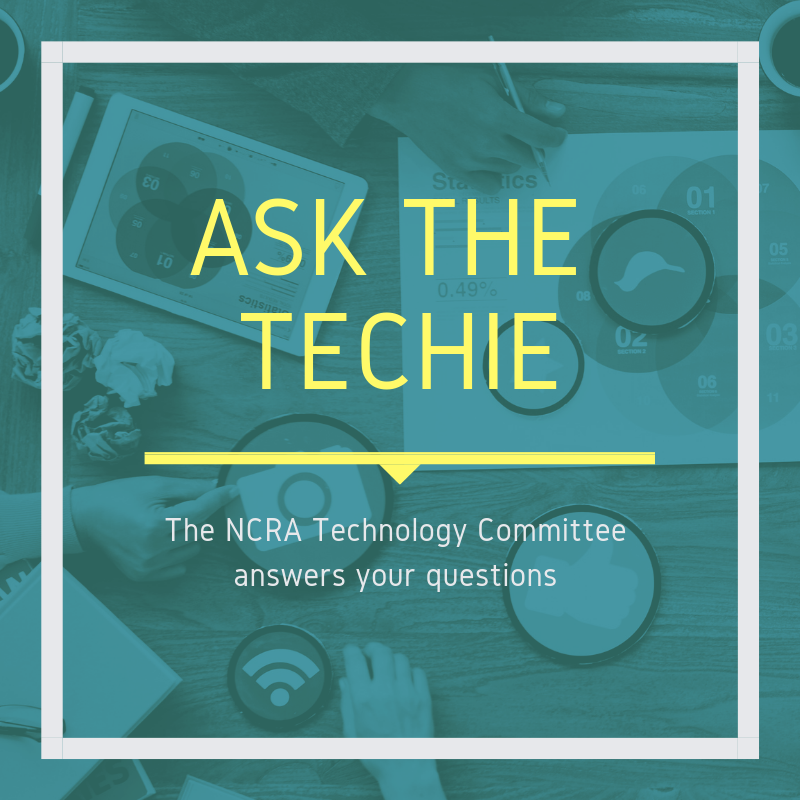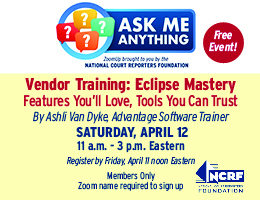
Dear Techie:
I am an aspiring realtimer and love to learn from more experienced and awesome realtime court reporters. My focus is on how to use briefs for parentheticals that explain to the attorneys what’s happening. I would love to have specific and easy-to-learn examples that I can incorporate into my dictionary.
Realtime Briefer
Dear Briefer:
Myrina A. Kleinschmidt, RMR, CRR, CRC, has some tips and briefs that you can start using today! She writes:
I like the briefs for parentheticals that explain to the attorneys what’s happening. It always distracts me when I see an attorney staring quizzically at my realtime feed. So writing a quick note releases my concern, and I can get back to focusing on the job.
VAIR/VAIR – (Reporter Note: All quotes will be verified later.) I use this when I know I didn’t get quoted material accurately.
CLEAR/CLEAR – (<<<<Momentary transmission lapse. Stand by.<<<) I use similar wording to this when I really mess something up and I don’t want them to see it on my screen. The < are paragraphs so add as many as you need to clear the screen.
SPEL/SPEL – (Reporter Note: All spellings will be confirmed after the depo.)
SLOE/SLOE – (Reporter Note: Slow down, please, especially when reading from documents.)
BREAK/BREAK – (Reporter Note: Reporter would like a bathroom break when convenient.) Write this when you see an attorney is viewing the screen; usually then that attorney will interject and ask for a break for our reporter.
CLAIR/CLAIR – (Reporter clarification.) I use this when telling attorneys to speak one at a time, or whatever I am asking them for, because I cannot write myself talking. I may leave the parenthetical in for the final, or put in my actual words if I have the audio and feel it’s better to change the wording.
DRAFT/DRAFT – (Realtime Draft Transcript – Not for Official Use.) I add this throughout the day whenever I remember to do so. Good reminder to them that it’s just a draft. You can also use this when you know something didn’t translate correctly just as a reminder to them that it’s simply a draft.
Lisa Knight, FAPR, RDR, CRR, has some great options as well. Check them out!
Here are a couple of parentheticals I use almost every day when writing realtime.
SMAOT – <New Page><Parenthetical>ERROR CODE: ERROR #224, MAX SPEED INPUT EXCEEDED!! TEXT/STENO DROPPED TO COMMENT LINE – CHECK<New Line Paragraph><Colloquy>(Simultaneous crosstalk interrupted by the reporter.)<Colloquy>THE REPORTER: One at a time, counsel.
This automatically dashes the last speaker, clears the realtime screen (it helps get their attention), and then puts in the steno error code. Counsel don’t know that I’m the one that put the “error code” in the transcript, and I can stop them and blame the software for not being able to keep up with how fast I’m writing because of how fast they are talking. It’s great, and it works every time!
KLAOIF – <Parenthetical>(Reporter <Scanstop Begin>requested<Scanstop End> clarification.)<Answer>
I use this one when I am having to interrupt either the witness or the attorney to clarify what they are saying. I never stop to ask for a spelling, but if they are reading too fast (or mumbling) and I can’t understand what they are saying, I can’t write it down. I do not dig out of the audio for anything I may say on the record; I just use this parenthetical. And I have it surrounded by “scanstops” to alert me to this part of the transcript to review.
B*AM – <New Line Paragraph><New Line Paragraph><Colloquy> (***REMINDER <Scanstop Begin>FROM<Scanstop End> REPORTER: You are viewing a DRAFT transcript. Mistakes will be corrected in the FINAL certified transcript.)
I use this one when I know/feel like the words tranned funny (like Al Gore rhythm instead of algorithm) and I don’t have a chance to fix it quickly. All I have to do is write one quick word (B*AM) and this note populates into the transcript. That way, counsel know that I know of this issue – and to remind them it is not supposed to be a PERFECT transcript. It’s a DRAFT transcript.
Good luck on your journey and happy realtiming!












[…] published March 29, 2019, on TheJCR.com, a publication of the National Court Reporters Association and reprinted here with […]